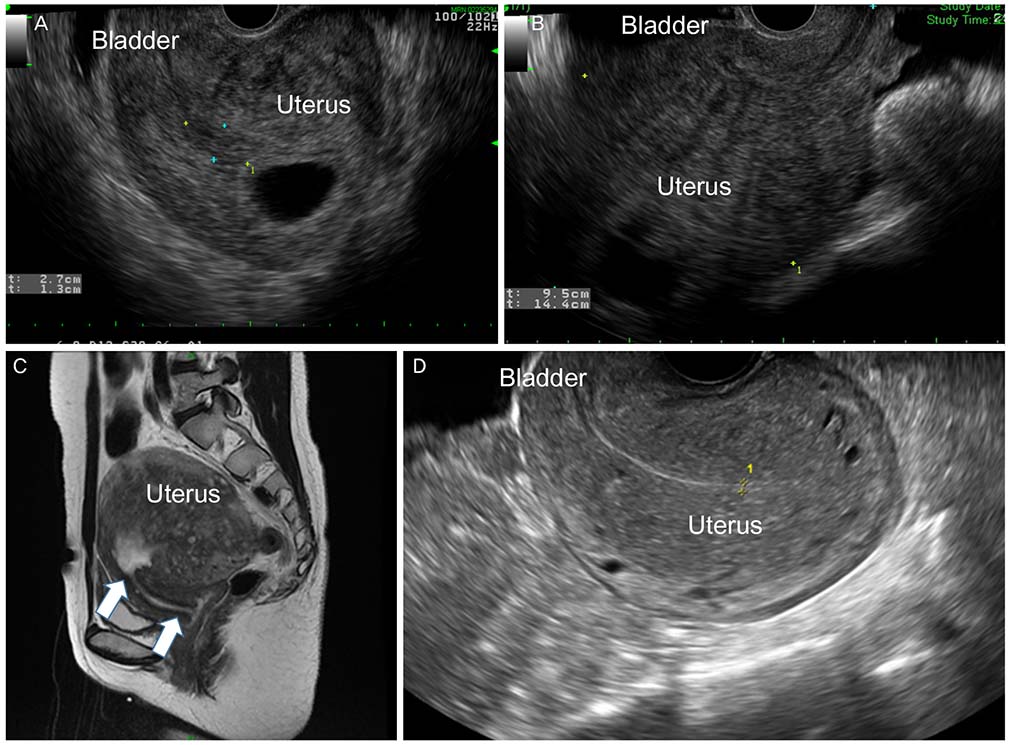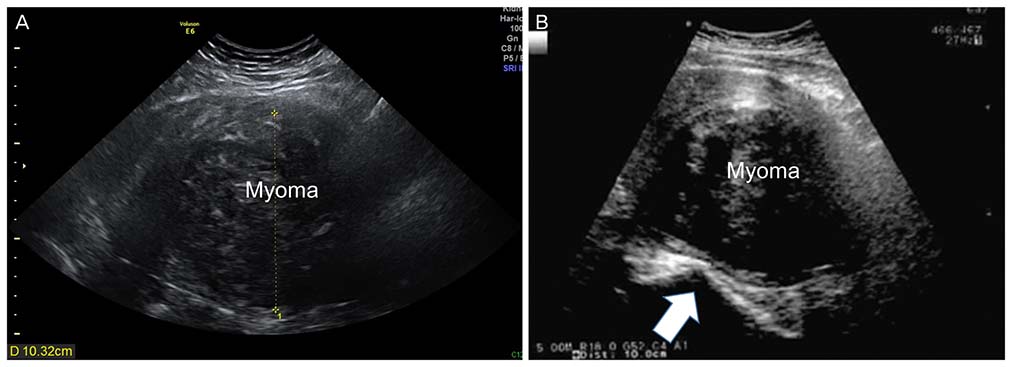Obstet Gynecol Sci.
2018 Sep;61(5):621-625. 10.5468/ogs.2018.61.5.621.
Incarceration of early gravid uterus with adenomyosis and myoma: report of two patients managed with uterine reduction
- Affiliations
-
- 1Department of Obstetrics and Gynecology, Ilsan Paik Hospital, Inje University College of Medicine, Goyang, Korea.
- 2Department of Obstetrics and Gynecology, Research Institute of Medical Science, Konkuk University School of Medicine, Seoul, Korea. 20050024@kuh.ac.kr
- KMID: 2426028
- DOI: http://doi.org/10.5468/ogs.2018.61.5.621
Abstract
- Although gravid uterine incarceration is typically diagnosed during the early second trimester, we encountered two unusual cases in early pregnancy. A 34-year-old multiparous woman with adenomyosis presented at 7 + 2 weeks of gestation with increased urinary frequency and a sensation of incomplete bladder emptying. The uterine incarceration was successfully reduced by manual reduction and pessary insertion, and she delivered a normal infant at term. In the second case, a 31-year-old nulliparous woman with a large myoma complained of dysuria, acute urinary retention, and intense back pain at 6 weeks of gestation. Manual reduction was successful in the knee-chest position. Subsequent pessary insertion failed; however, a slight reduction in pain was achieved. After a week, the fetus spontaneously aborted. In summary, gravid uterine incarceration is a rare but potentially fatal condition for the fetus, and a suspicion of this condition in patients with urinary symptoms, especially urinary retention and pelvic pain, is important in the early gestation period.
Keyword
MeSH Terms
Figure
Reference
-
1. Longo LD. On retroversion of the uterus. Am J Obstet Gynecol. 1978; 131:95–96.2. Weekes AR, Atlay RD, Brown VA, Jordan EC, Murray SM. The retroverted gravid uterus and its effect on the outcome of pregnancy. BMJ. 1976; 1:622–624.
Article3. Singh MN, Payappagoudar J, Lo J, Prashar S. Incarcerated retroverted uterus in the third trimester complicated by postpartum pulmonary embolism. Obstet Gynecol. 2007; 109:498–501.
Article4. Jacobsson B, Wide-Swensson D. Incarceration of the retroverted gravid uterus--a review. Acta Obstet Gynecol Scand. 1999; 78:665–668.5. Love JN, Howell JM. Urinary retention resulting from incarceration of a retroverted, gravid uterus. J Emerg Med. 2000; 19:351–354.
Article6. O'Grady JP, Pope CS, Darouian Z. Malposition of the uterus [Internet]. New York, NY: Medscape;2006. cited 2007 Sep 23. Available from: www.emedicine.com/med/topic3473.htm.7. Crichton EC. The significance of the retroverted uterus in obstetrics and gynaecology. S Afr Med J. 1959; 33:129–131.8. Gottschalk EM, Siedentopf JP, Schoenborn I, Gartenschlaeger S, Dudenhausen JW, Henrich W. Prenatal sonographic and MRI findings in a pregnancy complicated by uterine sacculation: case report and review of the literature. Ultrasound Obstet Gynecol. 2008; 32:582–586.
Article9. Chauleur C, Vulliez L, Seffert P. Acute urine retention in early pregnancy resulting from fibroid incarceration: proposition for management. Fertil Steril. 2008; 90:1198.e7–1198.10.
Article10. Dierickx I, Mesens T, Van Holsbeke C, Meylaerts L, Voets W, Gyselaers W. Recurrent incarceration and/or sacculation of the gravid uterus: a review. J Matern Fetal Neonatal Med. 2010; 23:776–780.
Article11. Hooker AB, Bolte AC, Exalto N, Van Geijn HP. Recurrent incarceration of the gravid uterus. J Matern Fetal Neonatal Med. 2009; 22:462–464.
Article12. Rose CH, Brost BC, Watson WJ, Davies NP, Knudsen JM. Expectant management of uterine incarceration from an anterior uterine myoma: a case report. J Reprod Med. 2008; 53:65–66.13. Myers DL, Scotti RJ. Acute urinary retention and the incarcerated, retroverted, gravid uterus. A case report. J Reprod Med. 1995; 40:487–490.14. Shnaekel KL, Wendel MP, Rabie NZ, Magann EF. Incarceration of the gravid uterus. Obstet Gynecol Surv. 2016; 71:613–619.
Article
- Full Text Links
- Actions
-
Cited
- CITED
-
- Close
- Share
- Similar articles
-
- Incarceration of the Gravid Uterus with Myoma: Report of One Patient Managed with Uterine Reduction
- Ultrasonographic findings of uterine myoma
- Uterine myoma and adenomyosis: sonographic findings and differentiation
- Asymptomatic Uterine Incarceration at Near-Term Pregnancy with a Successful Delivery Outcome: A Case Report and Review of Literature
- Torsion of a Myomatous Uterus in a Non-Gravid Female: A Case Report



